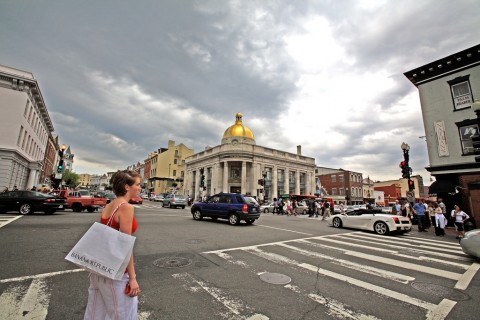Recent Posts
-

Charleston
Last month, I visited Charleston for the Democratic debate. Here are my thoughts on the debate itself. The next day, I got to walk around historic Charleston. It has some beautiful old Southern houses, and some great commercial streets with historic brightly colored townhouses. For a small city, it has some pedestrian activity in the evenings, though the jobs aren’t downtown… Keep reading…
-

Calculating walkability
The walkability of a neighborhood is an intangible quality that doesn’t appear on real estate listings like the number of bathrooms or the square footage. But living in a place where you can walk to grocery stores, restaurants, movie theaters, hair salons, and other amenities makes life in certain places enormously different (and, I believe, better) than those where driving… Keep reading…
-

Island Plan for new villages?
Martha’s Vineyard’s regional land use agency, the Martha’s Vineyard Commission, is conducting a broad participatory planning proccess, Island Plan, to solicit input and devise a long-term plan for the future of the island over the next 50 years. Still in its early stages, it covers topics such as housing affordability, year-round employment opportunities,… Keep reading…
-

Washington’s good streets and bad streets
Washington, DC is a city with some of the most magnificent public spaces and some of the worst at the same time. The Mall is mixed; it’s a huge tourist attraction with great, free museums and monuments, but many of the buildings present blank stone walls to the streets and there are too many cars, rendering it more of an empty grassy space between attractions than a destination in… Keep reading…
-

Yglesias on urbanism
Matt Yglesias wades into the debate about cities versus suburbs, and which is the future of America. Keep reading…
-

The Triboro RX
In the heyday of the railroads, rail lines crisscrossed the country and ran right through major cities. Some lines are commuter railroads today, others were turned into transit lines or highways, but many were abandoned. A few still exist, relatively unknown to most people, because they were either abandoned but never completely turned over to other uses, or because they carry some… Keep reading…
-

“Saving” a neighborhood in order to destroy it
Many neighborhoods in New York City have their local NIMBY civic groups, which believe that all development is bad and frequently use phrases like “preserving the low-rise character of the neighborhood” as arguments for resisting all development and all change. A group in and around the Bowery has such a petition now, which a friend forwarded to me, but I had to reply… Keep reading…
-

Grander Army Plaza
Brooklyn’s Grand Army Plaza could be a terrific public square. Qt the northern end of Prospect Park, it was designed by Frederick Law Olmsted and Calvert Vaux to be a gateway to Prospect Park, and features a beautiful arch modeled on Paris’s Arc de Triomphe. Keep reading…
-

Building real community in Allston
Drawing a pretty architectural diagram with lots of pictures of people is easy. Creating a real vibrant community where people want to go is harder. Harvard has noble intentions and many very good ideas for the new science campus (PDF) it is planning in Allston. I’ve praised it in the past. Keep reading…
-

Georgetown never blocked a Metro stop
Conventional wisdom says that the Washington DC Metro was supposed to go to Georgetown (after all, it barely misses it between Rosslyn and Foggy Bottom), but NIMBY residents in the 1970s blocked the station. But it’s not true. Keep reading…
